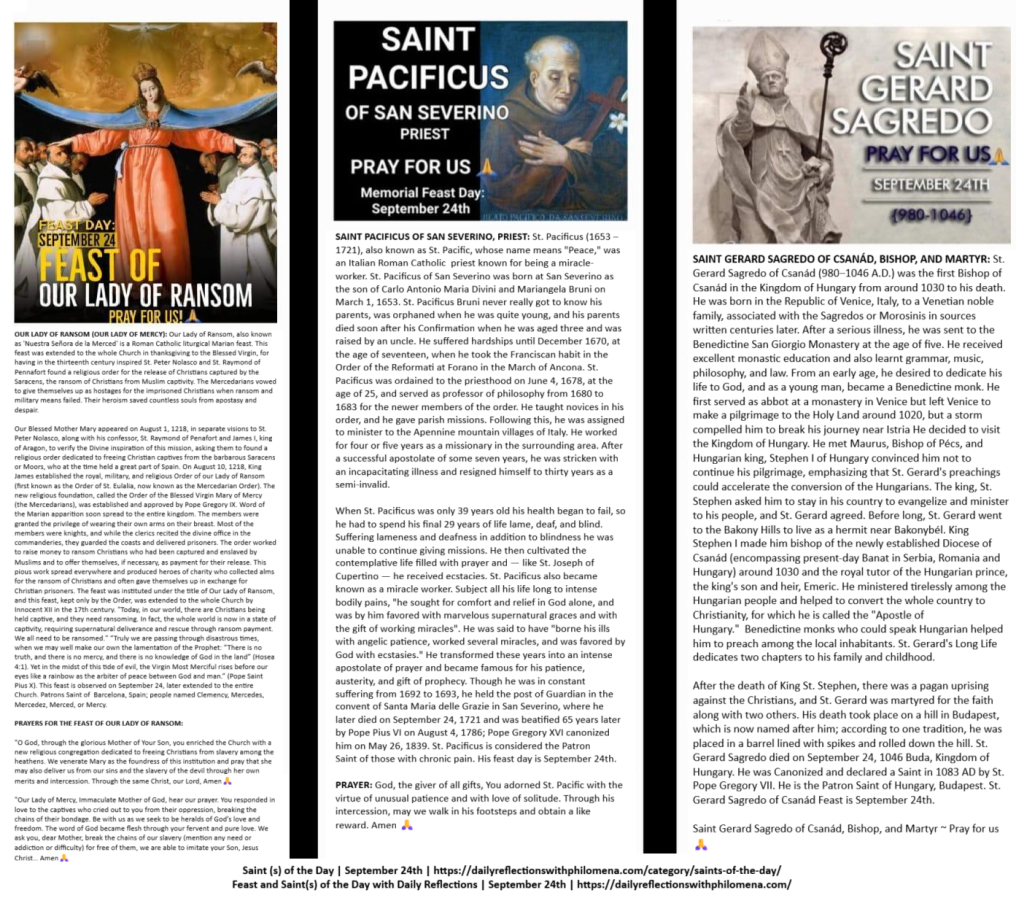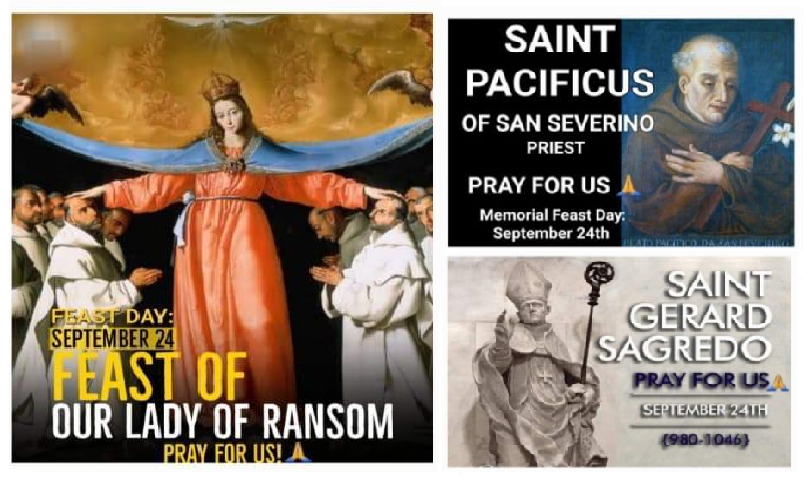
FEAST AND SAINTS OF THE DAY: FEAST OF OUR LADY OF RANSOM (OUR LADY OF MERCY) AND MEMORIAL OF SAINT PACIFICUS OF SAN SEVERINO, PRIEST AND SAINT GERARD SAGREDO OF CSANÁD, BISHOP AND MARTYR: Today, we celebrate the Feast of Our Lady of Ransom (Our Lady of Mercy) and the Memorial of Saint Pacificus of San Severino, Priest and Saint Gerard Sagredo of Csanád, Bishop and Martyr. Through the intercession of our Blessed Mother Mary, Mother of Mercy and the Saints on this feast day of Our Lady of Ransom, we humbly pray for the safety and well-being of all those in captivity, we pray for God’s grace and divine mercy upon them. We pray for the sick and dying, especially those who are sick with mentally and physically ill, chronic pain and those suffering from cancers and other terminal diseases. We pray for the souls in Purgatory and the repose of the souls of the faithful departed. We pray for all widows and widowers. We pray for the poor and needy, for peace, love, and unity in our marriages, our families, and our world. And we continue to pray for our Holy Father, the Bishops, the Clergy, for vocations to the priesthood and religious life, for the Church, for persecuted christians, for the conversion of sinners, and Christians all over the world…. Amen🙏
OUR LADY OF RANSOM (OUR LADY OF MERCY): Our Lady of Ransom, also known as ‘Nuestra Señora de la Merced’ is a Roman Catholic liturgical Marian feast. This feast was extended to the whole Church in thanksgiving to the Blessed Virgin, for having in the thirteenth century inspired St. Peter Nolasco and St. Raymond of Pennafort found a religious order for the release of Christians captured by the Saracens, the ransom of Christians from Muslim captivity. The Mercedarians vowed to give themselves up as hostages for the imprisoned Christians when ransom and military means failed. Their heroism saved countless souls from apostasy and despair.
Our Blessed Mother Mary appeared on August 1, 1218, in separate visions to St. Peter Nolasco, along with his confessor, St. Raymond of Penafort and James I, king of Aragon, to verify the Divine inspiration of this mission, asking them to found a religious order dedicated to freeing Christian captives from the barbarous Saracens or Moors, who at the time held a great part of Spain. On August 10, 1218, King James established the royal, military, and religious Order of our Lady of Ransom (first known as the Order of St. Eulalia, now known as the Mercedarian Order). The new religious foundation, called the Order of the Blessed Virgin Mary of Mercy (the Mercedarians), was established and approved by Pope Gregory IX. Word of the Marian apparition soon spread to the entire kingdom. The members were granted the privilege of wearing their own arms on their breast. Most of the members were knights, and while the clerics recited the divine office in the commanderies, they guarded the coasts and delivered prisoners. The order worked to raise money to ransom Christians who had been captured and enslaved by Muslims and to offer themselves, if necessary, as payment for their release. This pious work spread everywhere and produced heroes of charity who collected alms for the ransom of Christians and often gave themselves up in exchange for Christian prisoners. The feast was instituted under the title of Our Lady of Ransom, and this feast, kept only by the Order, was extended to the whole Church by Innocent XII in the 17th century. “Today, in our world, there are Christians being held captive, and they need ransoming. In fact, the whole world is now in a state of captivity, requiring supernatural deliverance and rescue through ransom payment. We all need to be ransomed.” “Truly we are passing through disastrous times, when we may well make our own the lamentation of the Prophet: “There is no truth, and there is no mercy, and there is no knowledge of God in the land” (Hosea 4:1). Yet in the midst of this tide of evil, the Virgin Most Merciful rises before our eyes like a rainbow as the arbiter of peace between God and man.” (Pope Saint Pius X). This feast is observed on September 24, later extended to the entire Church. Patrons Saint of Barcelona, Spain; people named Clemency, Mercedes, Mercedez, Merced, or Mercy.
PRAYERS FOR THE FEAST OF OUR LADY OF RANSOM:
“O God, through the glorious Mother of Your Son, you enriched the Church with a new religious congregation dedicated to freeing Christians from slavery among the heathens. We venerate Mary as the foundress of this institution and pray that she may also deliver us from our sins and the slavery of the devil through her own merits and intercession. Through the same Christ, our Lord, Amen🙏
“Our Lady of Mercy, Immaculate Mother of God, hear our prayer. You responded in love to the captives who cried out to you from their oppression, breaking the chains of their bondage. Be with us as we seek to be heralds of God’s love and freedom. The word of God became flesh through your fervent and pure love. We ask you, dear Mother, break the chains of our slavery (mention any need or addiction or difficulty) for free of them, we are able to imitate your Son, Jesus Christ… Amen🙏
HAIL MARY: Hail Mary, full of grace, the Lord is with you; blessed are you among women, and blessed is the fruit of your womb, Jesus. Holy Mary, Mother of God, pray for us sinners now and at the hour of our death. Amen.🙏
THE MEMORARE: Remember, O most gracious Virgin Mary, that never was it known that anyone who fled to thy protection, implored thy help, or sought thine intercession was left unaided Inspired by this confidence, I fly unto thee, O Virgin of virgins, my mother; to thee do I come, before thee I stand, sinful and sorrowful. O Mother of the Word Incarnate, despise not my petitions, but in thy mercy hear and answer me. Amen 🙏
SAINT PACIFICUS OF SAN SEVERINO, PRIEST: St. Pacificus (1653 – 1721), also known as St. Pacific, whose name means “Peace,” was an Italian Roman Catholic priest known for being a miracle-worker. St. Pacificus of San Severino was born at San Severino as the son of Carlo Antonio Maria Divini and Mariangela Bruni on March 1, 1653. St. Pacificus Bruni never really got to know his parents, was orphaned when he was quite young, and his parents died soon after his Confirmation when he was aged three and was raised by an uncle. He suffered hardships until December 1670, at the age of seventeen, when he took the Franciscan habit in the Order of the Reformati at Forano in the March of Ancona. St. Pacificus was ordained to the priesthood on June 4, 1678, at the age of 25, and served as professor of philosophy from 1680 to 1683 for the newer members of the order. He taught novices in his order, and he gave parish missions. Following this, he was assigned to minister to the Apennine mountain villages of Italy. He worked for four or five years as a missionary in the surrounding area. After a successful apostolate of some seven years, he was stricken with an incapacitating illness and resigned himself to thirty years as a semi-invalid.
When St. Pacificus was only 39 years old his health began to fail, so he had to spend his final 29 years of life lame, deaf, and blind. Suffering lameness and deafness in addition to blindness he was unable to continue giving missions. He then cultivated the contemplative life filled with prayer and — like St. Joseph of Cupertino — he received ecstacies. St. Pacificus also became known as a miracle worker. Subject all his life long to intense bodily pains, “he sought for comfort and relief in God alone, and was by him favored with marvelous supernatural graces and with the gift of working miracles”. He was said to have “borne his ills with angelic patience, worked several miracles, and was favored by God with ecstasies.” He transformed these years into an intense apostolate of prayer and became famous for his patience, austerity, and gift of prophecy. Though he was in constant suffering from 1692 to 1693, he held the post of Guardian in the convent of Santa Maria delle Grazie in San Severino, where he later died on September 24, 1721 and was beatified 65 years later by Pope Pius VI on August 4, 1786; Pope Gregory XVI canonized him on May 26, 1839. St. Pacificus is considered the Patron Saint of those with chronic pain. His feast day is September 24th.
PRAYER: God, the giver of all gifts, You adorned St. Pacific with the virtue of unusual patience and with love of solitude. Through his intercession, may we walk in his footsteps and obtain a like reward. Amen 🙏
SAINT GERARD SAGREDO OF CSANÁD, BISHOP, AND MARTYR: St. Gerard Sagredo of Csanád (980–1046 A.D.) was the first Bishop of Csanád in the Kingdom of Hungary from around 1030 to his death. He was born in the Republic of Venice, Italy, to a Venetian noble family, associated with the Sagredos or Morosinis in sources written centuries later. After a serious illness, he was sent to the Benedictine San Giorgio Monastery at the age of five. He received excellent monastic education and also learnt grammar, music, philosophy, and law. From an early age, he desired to dedicate his life to God, and as a young man, became a Benedictine monk. He first served as abbot at a monastery in Venice but left Venice to make a pilgrimage to the Holy Land around 1020, but a storm compelled him to break his journey near Istria He decided to visit the Kingdom of Hungary. He met Maurus, Bishop of Pécs, and Hungarian king, Stephen I of Hungary convinced him not to continue his pilgrimage, emphasizing that St. Gerard’s preachings could accelerate the conversion of the Hungarians. The king, St. Stephen asked him to stay in his country to evangelize and minister to his people, and St. Gerard agreed. Before long, St. Gerard went to the Bakony Hills to live as a hermit near Bakonybél. King Stephen I made him bishop of the newly established Diocese of Csanád (encompassing present-day Banat in Serbia, Romania and Hungary) around 1030 and the royal tutor of the Hungarian prince, the king’s son and heir, Emeric. He ministered tirelessly among the Hungarian people and helped to convert the whole country to Christianity, for which he is called the “Apostle of Hungary.” Benedictine monks who could speak Hungarian helped him to preach among the local inhabitants. St. Gerard’s Long Life dedicates two chapters to his family and childhood.
After the death of King St. Stephen, there was a pagan uprising against the Christians, and St. Gerard was martyred for the faith along with two others. His death took place on a hill in Budapest, which is now named after him; according to one tradition, he was placed in a barrel lined with spikes and rolled down the hill. St. Gerard Sagredo died on September 24, 1046 Buda, Kingdom of Hungary. He was Canonized and declared a Saint in 1083 AD by St. Pope Gregory VII. He is the Patron Saint of Hungary, Budapest. St. Gerard Sagredo of Csanád Feast is September 24th.
Saint Gerard Sagredo of Csanád, Bishop, and Martyr ~ Pray for us 🙏
